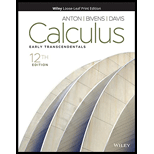
Concept explainers
From Exercise 1.5.58, under the assumptions that
Apply this result, if needed, to find the limit.
Want to see the full answer?
Check out a sample textbook solution
Chapter 1 Solutions
Calculus: Early Transcendentals, Enhanced Etext
- If a functionfis increasing on (a,b) and decreasing on (b,c) , then what can be said about the local extremum offon (a,c) ?arrow_forwardDetermine if the statemment is true or false. If the statement is false, then correct it and make it true. If the function f increases on the interval -,x1 and decreases on the interval x1,, then fx1 is a local minimum value.arrow_forwardDetermine if the statemment is true or false. If the statement is false, then correct it and make it true. If the function f decreases on the interval -,x1 and increases on the interval x1,, then fx1 is a local maximum value.arrow_forward
- Consider the following graph of the function f. АУ X-0- lim f(x) = x→0+ -3 -2 -1 4 3+ True False 2 - + 2 Find the following one-sided limits. (If an answer does not exist, enter DNE.) lim f(x) = y = f(x) 3 4 5 6 Determine whether the statement is true or false. lim f(x) = 2 Xarrow_forward7. Use the definition of the limit of a function to show that if lim f(x) = a and lim g(x) = b, xx⁰ x→x0 then limx→x (f(x) + g(x)) = a +b.arrow_forwardCharacterize the discontinuity for F(X)arrow_forward
- Which of the following statements about the function y = f(x) graphed here are true, and which are false? y = f(x) a. lim f(x) = 1 b. lim f(x) does not exist. c. lim f(x) = 2 X→2 d. lim f(x) = 2 e. lim f(x) = 1 f. lim f(x) does not exist. +1* g. lim f(x) = lim f(x) h. lim f(x) exists at every c in the open interval (–1, 1). i. lim f(x) exists at every c in the open interval (1, 3). j. lim f(x) = 0 k. lim f(x) does not exist. X- 2.arrow_forward8. Suppose that f is a continuous function with f(x) > 0 for all real numbers r, and lim f(x) = 0 = lim f(x). Prove that there is some number y such that f(y) > f(x) for all r.arrow_forward1. For any function f(x) such that the number a is in the domain of the function, lim,→a f(x) = f(a). True/False? Justify.arrow_forward
- 3. Evaluate lim f(x), given that: x→3 A • lim f(√x) = 4 x→9 the function f is continuous over (-∞0,00). Hint: If g(x)=√x, then lim f(√x) = lim f(g(x)) = 7-9 7-9arrow_forward1. Consider the given piecewise function f(x), find the limits at the given values. State if the limit does not exist. lim f(x) : а. X→2- b. lim f(x) = x→2+ 2 c. lim f (x) 24 С. X→2 -5 -3 -2 2 3 4 5 7 -1- -2 -3 -5 Xarrow_forward

 College Algebra (MindTap Course List)AlgebraISBN:9781305652231Author:R. David Gustafson, Jeff HughesPublisher:Cengage Learning
College Algebra (MindTap Course List)AlgebraISBN:9781305652231Author:R. David Gustafson, Jeff HughesPublisher:Cengage Learning

